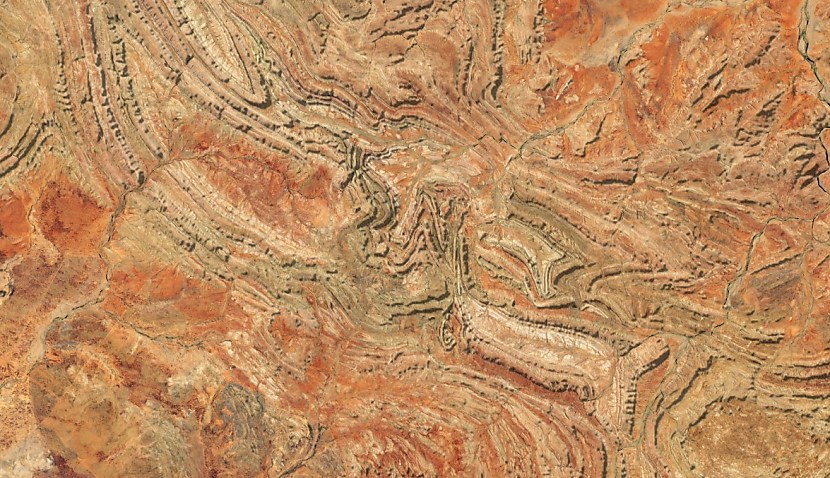
The collision gouged a canoe-shaped trough in the Davenport Range about one kilometre wide and five kilometers long, but its effect on nearby rocks stretched 10 kilometres.
The discovery was made by the Landsat 8 spacecraft and comes ahead of Australia joining the Landsat Next Earth observation program in the next decade.
“About 600 million years ago, during the Ediacaran Period, Earth was a vastly different place,” NASA said.
“The land, having recently shed a global blanket of slushy ice, was mostly barren and lifeless. However, an array of bizarre, soft-bodied creatures thrived in shallow seas, including worm-like organisms with crescent heads, spiral-shaped mounds with unusual trilateral symmetry, and fern-like fronds that grew several feet tall.
“Creatures like these may have been obliterated when an asteroid, thought to be roughly 200–400 metres (700–1,300 feet) across, blazed through the sky and smashed into land or shallow waters around what is now the Davenport Range of northern Australia.
“While much of the original impact crater has eroded, telltale signs of the collision remain imprinted on the folded sedimentary and volcanic rock layers.”
NASA believes the narrow shape of the crater and pattern of deformation it created are signs the asteroid struck at an extremely oblique angle.
“A steeper-angle asteroid impact – such as the one that doomed the dinosaurs – would have left a deeper, more symmetrical crater and created an elevated feature in the centre of the crater, known as a central uplift.
“Other telltale clues of an impact event at Amelia Creek are buried in nearby quartzite rock strata. Starting in the 1980s, geologists discovered fan-shaped fractures, later identified as shatter cones – rare geologic features that only form when impact events send shock waves barreling through rock.
“All of the area’s shatter cones are distributed in a crescent-like pattern mainly to the south of the crater, another sign that the asteroid struck at a shallow angle.”
NASA said the amount of damage caused by the impact is “unclear”, but asteroids that strike at shallow angles tend to cause less damage than those that strike at steeper trajectories.
“The shallow angle means the rocky body passes through Earth’s atmosphere for a longer distance, burning off more mass and often breaking into smaller pieces before impact.”
The Landsat 8 satellite payload consists of two science instruments: the Operational Land Imager (OLI) and the Thermal Infrared Sensor (TIRS).
It was developed as a collaboration between NASA and the US Geological Survey and launched in 2013.
Last year, Australia formally joined the Landsat Next Earth observation program, which aims to capture images in super-high resolution.
It’s hoped the resulting pictures will enable governments and organisations to better manage crops, enhance urban environments and improve responses to natural disasters.
Australia is currently reliant on international Earth observation satellites after it controversially shelved plans to create its own last year.

Adam Thorn
Adam is a journalist who has worked for more than 40 prestigious media brands in the UK and Australia. Since 2005, his varied career has included stints as a reporter, copy editor, feature writer and editor for publications as diverse as Fleet Street newspaper The Sunday Times, fashion bible Jones, media and marketing website Mumbrella as well as lifestyle magazines such as GQ, Woman’s Weekly, Men’s Health and Loaded. He joined Momentum Media in early 2020 and currently writes for Australian Aviation and World of Aviation.
Receive the latest developments and updates on Australia’s space industry direct to your inbox. Subscribe today to Space Connect here.









